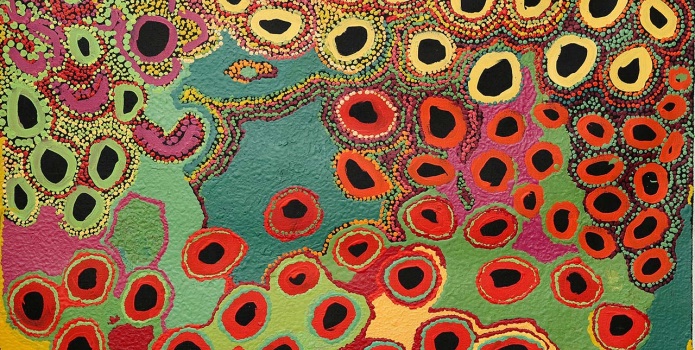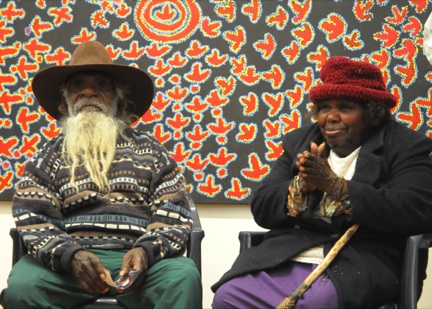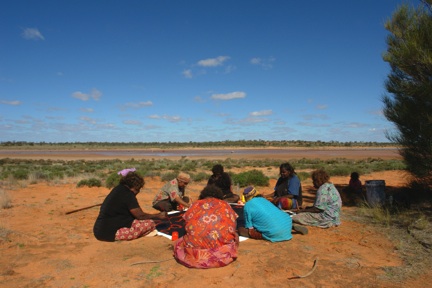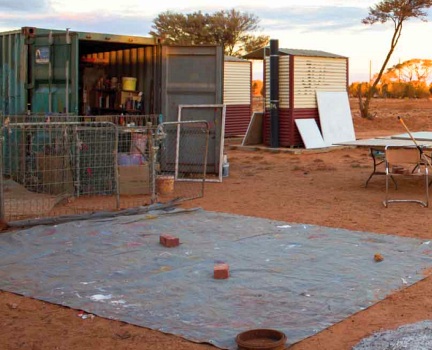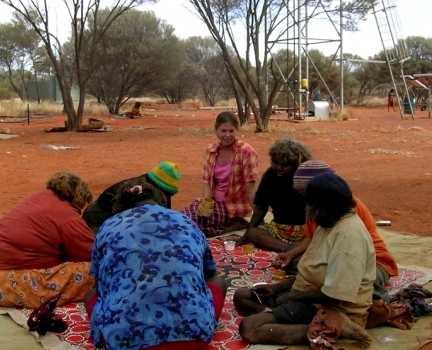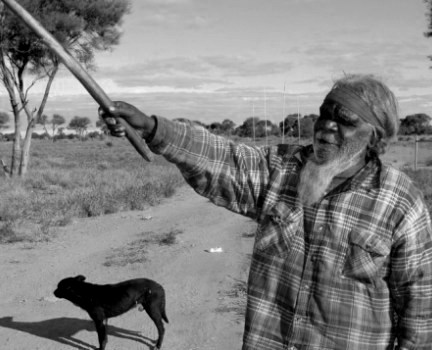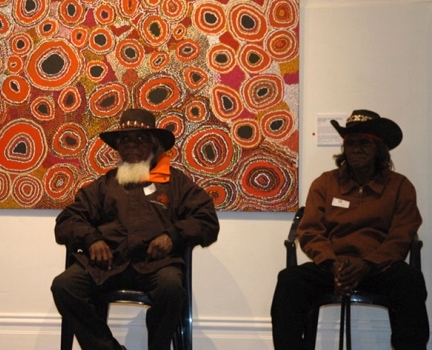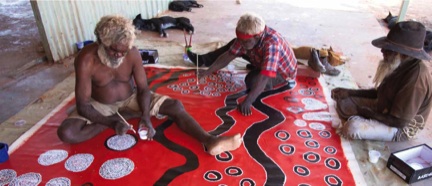Working With The Spinifex Arts Project
Amanda Dent and her partner Brian Hallett are the Spinifex Arts Project Managers. They moved to the remote area Wingellina (or Irrunytju) in the Ngaanyatjarra Lands in 1999. In 2000, with the support of the Irrunytju Community Council, the women and Amanda started Irrunytju Arts, her first time working for Western Desert Artists. Brian and Amanda went on to establish other successful art centres in the region - Ninuku Arts at Kalka and Tjungu Palya at Nyapari in the APY Lands, where they worked for 7 years. In 2012 they began work for the Spinifex Arts Project.
In this interview Amanda discusses how the Spinifex Arts Project operates.
Q: You began working with the Spinifex artists in 2012. Were there particular qualities to their way of working that were different?
I’d been working for over ten years in the Ngaanyatjarra and APY Lands (1999 to 2012). In communities to the North things have changed a lot in 12 years, a lot of the older artists have passed away now. The artists that we worked with 12 years ago remind me of the Spinifex artists painting today.
There's something about intuitively drawing on strong cultural knowledge using traditional iconography. Some of the artists paint in a style that’s quite sparse. There's a real confidence in the mark making that comes directly from that confidence of knowing the country and not knowing so much about the mainstream culture. They're not worrying about how it's going to be perceived outside. They're just painting what they know.
Q: What are the special challenges for arts workers in remote desert communities?
Working cross-culturally is a challenge, understanding how people communicate. The desert people aren't always direct. It can be hard because traditionally people don't say no to your face, that's considered quite a rude thing. When you're talking to people you have to be very careful to understand whether people are saying yes because they don't want to offend, or yes because they agree.
Many things have to be done communally. You have to have the right group of people present when you're asking a question. Depending on your relationship with the group, they might not tell you that they can't really make a decision because somebody who needs to be there isn't there. You need to learn all those little things to build relationships.
Sometimes the diversity is a challenge because often you're a resource for so many things beyond an arts project.
Q: You're involved in the day-to-day welfare of the people as well?
To a degree. Tjuntjuntjara is a very good community because there's quite a lot of other staff and community services here. There's a very good clinic and the community office is great and there's an aged care program that functions very well. We're finding Tjuntjuntjara a good, strong and cohesive community where there's a lot of fantastic things in place which means that people coming to the Arts Centre are relatively well serviced.
In some other communities that's not the case. Then the Art Centre does a lot of extra work such as filling in Centrelink forms, worrying about people's health or getting people to appointments for the doctor.
Q: What gives you the greatest reward for the work you do?
The community development. I love the art centre work because I love great paintings, and seeing artists feeling empowered and gaining confidence.
Arts and cultural work can be really empowering for the artists because they can interact with mainstream Australia on their own terms. When you see the artists doing that it is very powerful, the recognition that they get for the value of culture and the Anangu way of life outside of their community.
When an artist goes to an exhibition and they see that there are non-indigenous people who are really genuinely interested in them, their culture, their painting and their stories, the artists then find that very empowering. Because they're being valued. What they value, somebody else is valuing. You see people just go from strength to strength when that starts to happen.
Sometimes in communities people aren't always at their best. When they go out into mainstream Australia to a gallery opening and they meet people who just think they're wonderful and treat them with respect and want to know about the culture and the country, and want to know about them, it gives them a renewed sense of self-esteem. That's the most rewarding thing for me.
Sometimes younger people maybe don't think that they can paint, or think painting has to be what they've seen in storybooks. Then you might see them suddenly get what art is, that art is not just painting for money, that it's a creative expression drawing on something very deep within you. When you see young people step up and produce amazing work - that they're amazed themselves to have produced - that's also one of the highlights of my job.
Q: What is it that the elders bring to an arts project like the one at Spinifex? Do they help the younger people develop?
They bring the cultural knowledge and a way of seeing the world. Their way of being in the world is so different. Their whole being, their whole presence, their way of making marks on the canvas is very special.
I've never met an old person that can't paint. It's very interesting. Every old person they'll say to you, "Oh, I can't paint. I'm Nurpa. I don't know." You say, "It doesn't matter. Just do it anyway." They always do amazing paintings.
Q. What are the cultural or social effects of having senior artists working in community?
It gives a relevance to that cultural knowledge for younger people. Younger people can be very much influenced by TV and what's happening outside and maybe Black American culture and other things. One of the things they'd see with a successful painting project is that the cultural knowledge the elders hold has significance beyond just in community. It is something that mainstream Australia is interested in, and can offer employment if they learn that knowledge.
Q: Where do you think the arts project is going to be in 10 to 15 years time?
Hopefully it will have some more infrastructure. Even though it's been running for over 15 years, the Spinifex Arts Project has no dedicated infrastructure, no staff house, studio or vehicle.
The Spinifex Arts Project has an amazing group of artists who are very committed, but no capacity to employ a manager and house them, and no place for the artists to work. There's a housing crisis in the community and most of the staff already share whatever housing stock there is.
We need to secure some sort of staff housing so that the project can employ a full-time manager. We don't work here full-time, we come and go. Because there's no art studio, we can't be here over the summer because it's just too hot for the artists to work outside - the project more or less closes down.
To be sustainable, the project needs to branch out to younger members in the community. Younger people want to get involved, the drive is there. But it's very hard without any infrastructure. If the general manager was to leave her position, we'd have no guarantee that we'd even be able to stay in this house.
Q: Is the preservation and transfer of culture of high importance to the artists?
That happens anyway because art, painting, is not a traditional cultural practice really. For Anangu the important thing is the ceremonial singing and dancing, the songlines. That's number one. Painting is a modern interpretation of the Tjukurpa. Go out and perform. Men's business is still very important. Spinifex elders are often called on as they hold knowledge for different aspects of men's business or other business.
The core material that people are drawing on to make paintings is still very prevalent and very important to the community.
Q: How long do you think most arts coordinators can reasonably work in a remote community for?
It depends on the support you have from your board. Most art centres are incorporated bodies if you've got a good board and a good group of artists working together as a team, art centre managers potentially can stay a very long time. Working in the arts and cultural area is very rewarding because you're constantly learning about culture, and it is something that makes people happy. Arts and culture are probably one of the best areas you can work in for remote communities. You're not constantly being drained like a community office or if you're the centre link agency person.
In some other communities that aren't well resourced, demands can get out of control. There may not be a strong board or good communication. Workers can get totally overworked and very stressed. Those things will make it almost impossible to stay a long time.
It takes two to three years to really get to know a community and the people before you can really start moving forward. If each manager is only going to give three years then really the community is just at that point where they've trained you up and you've gone. They've lost all that investment because every time a new staff member comes to a community they have to be trained. They have to learn what's appropriate, who the important people are, what the sites are, how things are done because every community is different.
Something that might have worked for us at Napari or Wingellina or other communities, won't necessarily work for us here at Tjuntjuntjara. We've got to be open to listening and learning what the correct way to do things is and what's going to work here.
So you can stay a long time with support from the artists. That's one of the great things about working here with the Spinifex mob is that they really are an amazing group of people. They are very, very generous, really appreciative, very, very loving and warm.
They're funny, they have a great sense of humour. It's been a real pleasure for us to get to know them and to work with them.
Related Articles
- Everyday Spirituality: Paintings from The Spinifex Arts Project
- Australian Aboriginal Art Centre Management
Paintings

